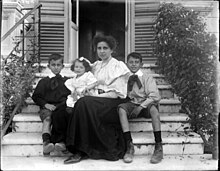Enrichetta Chiaraviglio-Giolitti | |
|---|---|
 (l-r) Tito, Marcella, Enrichetta, and Curio Chiaraviglio, 1909 | |
| Born | Enrichetta Giolitti 1871 |
| Died | 17 April 1959 (aged 87–88) Martínez, Buenos Aires, Argentina |
| Other names | Enriqueta Chiaraviglio Giolitti, Enriqueta Giolitti de Chiaraviglio, Enrichetta Giolitti Chiaraviglio |
| Occupation(s) | Philanthropist, activist |
| Spouse | |
| Children | 4 |
| Father | Giovanni Giolitti |
| Relatives | Lorenzo Sobrero (grandfather) Ascanio Sobrero (great-uncle) |
Enrichetta Chiaraviglio-Giolitti (1871 – 17 April 1959) was an Italian philanthropist, educational patron and activist. Born in Florence, she was the oldest daughter of five-time Prime Minister of Italy, Giovanni Giolitti. An astute and intellectual woman, she was his confidant and correspondent although they did not always agree on policy. Interested in improving children's education in Italy, she worked with several associations and on commissions to study and create curricula. She was a supporter of the Italian educator Maria Montessori and persuaded Margherita of Savoy, queen of Italy, to become a patron of her schools.
After serving as temporary superintendent of the Scuola professionale femminile "Margherita di Savoia" ("Margherita di Savoia" Vocational School for Girls) in 1910, she founded the Istituto di San Gregorio al Celio (Institute of San Gregorio al Celio). The institute taught childcare to mothers and trained schoolteachers as in-home health visitors and inspectors. In 1912, concerned with the plight of street urchins, she put forward the idea of refitting a derelict ship as a floating school to Pasquale Leonardi Cattolica}, Minister of the Navy. The floating school Caracciolo was launched in 1913 under the direction of Giulia Civita, who had been proposed by Chiaraviglio-Giolitti. To fund the project, she organized the Unione Navi-Asilo (Union of Naval Asylum). The floating kindergarten operated until 1928 when it was closed by the fascist regime. She also worked on reforms of teacher training, attempted to establish secondary schools for girls, and pressed the government to offer agricultural education. Other initiatives included work with malarial children and on child protection laws.
As a women's rights activist, Chiaraviglio-Giolitti joined the Consiglio Nazionale delle Donne Italiane (National Council of Italian Women) and fought for women’s suffrage. In 1919, she was appointed to the national executive committee of the Women's International League for Peace and Freedom. In 1927, she and her family fled to Argentina to escape Benito Mussolini's regime. They established a metal-working business and participated in anti-fascist organizations. She continued her activism for women, children, and education in Buenos Aires, where she died in 1959. Throughout her life Chiaraviglio-Giolitti maintained a diary and was a prolific letter writer. Her letters are valuable in understanding the political currents of Italy during her lifetime.
